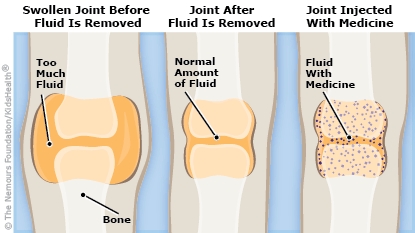Removing fluid from a joint or injecting medicine into it can help the joint move more easily, reduce swelling, treat pain, or help diagnose an illness.


Joints are where two bones meet, such as at the elbows, knees, shoulders, hips, and wrists. The area inside the joint (called the "intra-articular" area by health care providers) contains blood vessels and synovial fluid, which cushions the bones and acts as a lubricant to help them move easily.
In joint aspiration (also called "intra-articular aspiration" or "arthrocentesis"), a doctor carefully inserts a needle into a joint to remove fluid. A doctor usually does this to reduce pressure and swelling in the joint or to look at the fluid to diagnose a condition affecting the joint (such as arthritis).
In joint injection, the doctor uses a needle to put medicine — usually a corticosteroid (or sometimes a topical anesthetic) — in the joint. This type of medicine helps control pain and swelling. It takes a few days for injected corticosteroids to start working. Sometimes symptoms get a little worse until the medicine begins to work.
Joint aspiration and injection can be done together or separately. To prevent discomfort, the doctor may numb the area or give your child a sedative. Afterward, the joint is wrapped in a bandage.


Your child has: